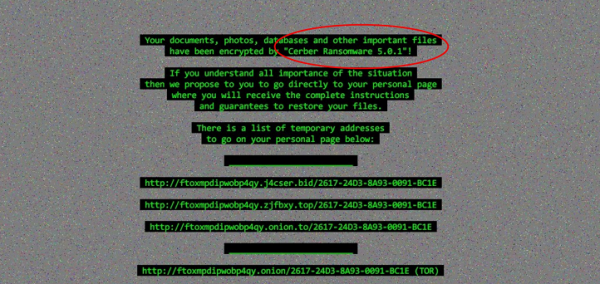Cerber 5.0.1 marks another outbreak of ransomware plague. As its name suggests, we have caught yet another member of the family. In a nutshell, the Cerber is the greatest challenge for the IT security. It is constantly evolving. The infection vectors get updated and renewed so that security prevention systems often fail to avoid the trespassers.

Currently, most of the infection cases involve RIG-V exploit. The encryption routine is also subject to ongoing improvement. That is to say; the modern encryption is really strong. That would take ages, without any exaggeration, to process the scrambled data back to the original content. Even if you take all the computing power available on Earth and somehow make it work together, you are unlikely to enjoy the successful end of the process. The decryption by brute force would take longer than any human being can last.
True, the encryption is really strong, but the crooks have a magic key. This key would undo the encryption in a snap, but the victims are supposed to give their money for that. How much is a good question. The payment is actually a ransom. The crooks want you to pay the amount they specify in the Bitcoins. The sum would vary.
That is a first peculiarity inherent in the Cerber 5.0.1 encryption virus. Unlike most of the counterparts, the ransomware in question customizes its attack. It would first collect the data on the compromised system. The bulk would stream to the remote server. The server seems to be a decision maker as it communicates back the adjustments, including the amount to be indicated in the ransom note. The ransom note is available in README.hta. The file itself emerges in any folder with the data scrambled by the ransomware. The virus basically spares very few files. The exemption applies to system files and a couple of insignificant formats. The overwhelming majority of the data on the PC hit by Cerber 5.0.1 becomes gibberish.
Rumors have it that the Cerber 5.0.1 ransoms the amount of USD500. First off, it specifies the sum payable in bitcoins. The rate of exchange for cryptocurrency is extremely fluctuating. During a single week, it may vary in within the range of 50% and even more. Again, the ransom is case specific. The victims also need to note any payments to the crooks do not ensure the decryption. Thereby, kindly follow the guidance below to get rid of Cerber 5.0.1 ransomware, data recovery included.
Automatic removal of Cerber 5.0.1 ransomware
The benefits of using the automatic security suite to get rid of this infection are obvious: it scans the entire system and detects all potential fragments of the virus, so you are a few mouse clicks away from a complete fix.
- Download and install recommended malware security suite
- Select Start Computer Scan feature and wait until the utility comes up with the scan report. Proceed by clicking on the Fix Threats button, which will trigger a thorough removal process to address all the malware issues compromising your computer and your privacy.
Restore files locked by Cerber 5.0.1 ransomware
Cerber 5.0.1 represents a unique category of malicious software whose attack surface reaches beyond the operating system and its components, which is why removing the virus itself is a part of the fix only. As it has been mentioned, it encrypts one’s personal information, so the next phase of the overall remediation presupposes reinstating the files that will otherwise remain inaccessible.
-
Launch data recovery software
Similarly to the rest of its fellow-infections, Cerber 5.0.1 most likely follows an operational algorithm where it erases the original versions of the victim’s files and actually encrypts their copies. This peculiarity might make your day, because forensics-focused applications like Data Recovery Pro are capable of restoring the information that has been removed. As the virus further evolves, its modus operandi may be altered – in the meanwhile, go ahead and try this.
-
Take advantage of Volume Shadow Copy Service
This technique is based on using the native backup functionality that’s shipped with Windows operating system. Also referred to as Volume Snapshot Service (VSS), this feature makes regular backups of the user’s files and keeps their most recent versions as long as System Restore is on. Cerber 5.0.1 virus hasn’t been found to affect these copies therefore the restoration vector in question is strongly recommended. The two sub-sections below highlight the automatic and manual workflow.
- a) Use Shadow Explorer
Shadow Explorer is an applet that provides an easy way of retrieving previous versions of files and folders. Its pro’s include an intuitive interface where the computer’s entire file hierarchy is displayed within one window. Just pick the hard disk volume, select the object or directory to be restored, right-click on it and choose Export. Follow the app’s prompts to get the job done.

- b) Use file properties
Essentially, what the above-mentioned Shadow Explorer tool does is it automates the process that can otherwise be performed manually via the Properties dialog for individual files. This particular approach is more cumbrous but just as effective as its software-based counterpart, so you can proceed by right-clicking on a specific file, which has been encrypted by Cerber 5.0.1 ransomware, and selecting Properties in the context menu. The tab named Previous Versions is the next thing to click – it displays available versions of the file by date of the snapshot creation. Pick the latest copy and complete the retrieval by following the prompts.

-
Data backups work wonders
Ransomware like Cerber 5.0.1 isn’t nearly as almighty and destructive in case you run regular file backups to the cloud or external data media. The virus itself can be completely removed in a matter of minutes, and the distorted information can then be just as easily recovered from the backup. Luckily, this is a growing trend, so ransom Trojans are hopefully going to become less subversive in the near future.
Verify thoroughness of the removal
Having carried out the instructions above, add a finishing touch to the security procedure by running an additional computer scan to check for residual malware activity
